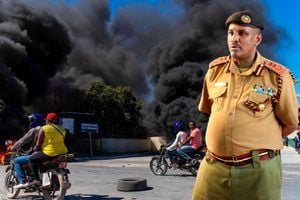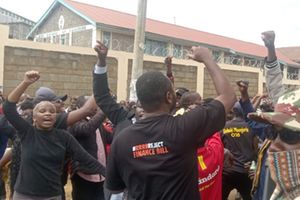Ask your question: What are you doing to ensure accuracy of weather forecasts?

Kenya Meteorological Department Director Stella Aura during an interview with the Nation on January 27, 2020.
What you need to know:
- Increased frequency of extreme weather events due to climate change and enlightenment of the population on the importance of weather and climate information has led to increased demand for weather information.
- What happens in the Kenyan atmosphere is dependent on global atmospheric systems, so it is not possible to make predictions of weather and climate in Kenya without taking into consideration the whole global system.
I guess your weather forecasting business has a lot to do with climate change. How much are these changes affecting your daily work? Francis Njuguna, Kiambu County
Increased frequency of extreme weather events due to climate change and enlightenment of the population on the importance of weather and climate information has led to increased demand for weather information. Weather forecasting has become complicated due to changes in the global weather triggers. This demands for heavy investment in technology, research and capacity building to cope with the changes. KMD is moving with the times and investing in up-to-date technology and continuous capacity building.
How many staffers do you have in total? Githuku Mungai, Nairobi
KMD has 39 weather observatories across the country and 47 county directors of meteorology. The department has a total of 600 personnel comprising of meteorologists, meteorological technologists, meteorological telecommunications officers; meteorological communications officers, mechanical and electronics engineers as well as support services, that is, human resources and management, procurement, accountants, clerical officers and auditors. Also included in this number are hospitality staff who run KMD’s Institute for Meteorological Training and Research hostel, a World Meteorological Organisation designated regional training centre.
Do you at times rely on information from other advanced countries or are you entirely self-reliant? Githuku Mungai, Nairobi
Climate science or meteorological services go beyond political boundaries. What happens in the Kenyan atmosphere is dependent on global atmospheric systems, so it is not possible to make predictions of weather and climate in Kenya without taking into consideration the whole global system. This makes it a must to collaborate with other countries across the world.
Kenya is a member of the World Meteorological Organisation (WMO). WMO has put in place protocols governing how its member states engage including how they share observed data across the globe. There are global specialised centres with sophisticated tools whose products KMD accesses freely or through subscription or other forms of agreements to complement data and information the department requires to generate national forecasts. KMD also generates products that other countries use to generate their forecasts.
One of the items in the President’s Big Four agenda is food security, which in turn heavily relies on weather patterns since much of our agriculture is rain-fed. How is your institution contributing to this important goal? Komen Moris, Uasin Gishu
The mandate of KMD is to provide accurate and timely early warning weather and climate information and services for the safety of life, protection of property and conservation of the environment for sustainable development.
In the food security sector, KMD operates as a Big Four Agenda enabler by providing farmers and other stakeholders in the agriculture sector with relevant information in a timely manner to enable them maximise on production and avoid losses by making the right decisions at the right time. KMD provides the onset, cessation and distribution of rainfall in a given season. This information guides the farmer, working in collaboration with the Ministry of Agriculture, on the type of seeds or crop to plant (short or long maturing), when to plant, weed, spray, use fertilizer, irrigate, among other steps in the agricultural value chain.
Some super powers have termed climate change as a conspiracy theory. Does your institution have empirical data to back up the explanation of climate change being felt in this country? What is your advice to the general populace? Komen Morris, Uasin Gishu
The impacts of climate change (CC) are being observed globally. According to the Intergovernmental Panel on Climate Change (IPCC) and several other studies, human-induced climate change is increasing and its impacts are being felt across all continents and oceans.
Kenya’s weather and climate are changing in response to global warming that is currently being experienced worldwide. KMD is the custodian of historical weather and climate data for the country. As part of its mandate, KMD carries out continuous monitoring and documentation of the state of the climate in Kenya by analysing data for signals of climate change and variability and preparing the state of the climate reports. Analysis carried out by KMD provides evidence of shifting climate patterns in Kenya such as rising temperatures and changing rainfall patterns, resulting in increased frequency and intensity of extreme weather events such as droughts and flooding that threaten the sustainability of the country’s development.
Owing to the global climate change, it follows that your department must adopt a more scientific weather data generation, compilation and analysis backed by secure and secure information technology software. What guarantee can you give on this? Dan Murugu, Nakuru
The department has already embraced technology and has embarked on a modernisation programme. A lot of investment in technology is taking place with regard to both data observation, collection, transmission/communication and weather prediction. This will guarantee provision of timely and accurate weather information
The Department is also building the capacity of its staff through research and training to handle the new and emerging issues.
Is there any way you can improve your department’s communication that is sometimes disregarded until it is too late? Jotham Ndung’u
KMD issues weather advisories from time to time in case of impending weather-related risks. This information is intended to be used for the safety of life and protection of property. Occasionally, weather-related disasters occur even when the advisory has been issued with good lead time. There is need to have the public and other stakeholders continuously educated and made aware of the importance of acting on the advisories.
How can people, especially farmers, adapt to climate change? Jotham Ndung’u
Farmers should work closely with the KMD and the Ministry of Agriculture to assist them make informed decisions with regard to the type of crops/seeds to grow, when to weed, when to apply fertiliser, when to harvest depending on the weather information for their area.
What does the current rise in water levels in lakes Baringo and Nakuru mean? Shem Onderi
The phenomenon of rising water levels in the Rift Valley is an issue which a multi-disciplinary team of scientists is still researching to establish the causes. It has been linked to various causes, including climate change and tectonic movements. Some of the theories fronted include increased degradation of the catchments and also increased extreme weather events like rainfall.
There were times when Kenyans, particularly farmers, had lost faith in the weather forecast since the predictions were not reliable. What have you done to ensure a high rate of accuracy? Dickie Murimi, Kirinyaga
The government has invested heavily in weather and climate observation network, modern technology and skills improvement through continuous training of staff and research. The Kenyan population has also become better informed on the importance of weather and climate information in their activities. Consequently, their uptake of this pertinent services has increased tremendously.
The month of September had two extremes: Very cold nights in the early weeks and very hot ones in the latter weeks of the month. What could be behind this? Duncan Waswa
The month of September is typically a transition month from the cold season of June to August to a predominantly drier and warmer September. The dynamics of the weather controlling systems during the transition this year led to an extended cold season during the first half of September 2020. This was followed by the typical warm September weather during the second half of the month.
When is the next big drought expected to hit Kenya? Githuku Muigai, Nairobi
Drought is a global phenomenon that occurs virtually in all landscapes causing significant damage both in the natural environment and in human lives. Due to the random nature of contributing factors, occurrence and severity of droughts can be treated as stochastic in nature. KMD is in the process of modelling various scenarios of possible future drought occurrences in Kenya.
Weather stations outside Nairobi are no longer functional, for example, due to land-grabbing. What are you doing about it? Dan Murugu, Nakuru
Weather stations outside Nairobi are operational. The few cases where parts of the station(s) land has been grabbed are being addressed. The department is moving fast to fence and get all its land parcels titled.
The climatic changes being witnessed world over have greatly affected seasons and have changed planting patterns, leading to crop failure because most farmers depend on rain to plant. How is the department adjusting accordingly to avoid misleading farmers? Shem Onderi
The department provides weather and climate information which is supposed to guide in planning and assist farmers in making informed decisions. The department has increased engagement with farmers to build their capacity to understand and interpret the forecasts at the national and county level. The farmers and other stakeholders need to understand that because of climate change rainfall seasons have shifted. There are also initiatives for co-production of climate services that will help build confidence in KMD products and services.
Are there other roles the Meteorological Department plays apart from weather forecasts that touch the lives of Kenyans? Dickie Murimi, Kirinyaga
Each government department has its role and responsibilities defined. The mandate of KMD is to provide accurate and timely weather and climate information. Apart from the general weather forecasts, the department generates pertinent weather information for the safety of air navigation (aviation) and marine transport. KMD also has a responsibility of monitoring and alerting on tsunamis; monitoring atmospheric and background pollution; and monitoring ozone depletion and climate change.
The Meteorological Department is a department in the Ministry of Environment and Forestry. The department is thus actively involved in the activities of the ministry including tree planting and waste management.
The department also supports the Dagoretti Children Rehabilitation Centre through individual, personal, staff members’ contributions in the form of money, food, clothes, etc.





